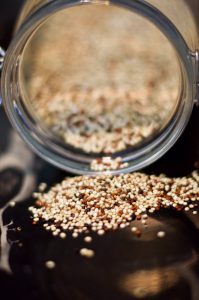 What is quinoa and why is it so popular? Quinoa is an ancient grain that the world has recently rediscovered. There are many health benefits of quinoa and it’s been used for centuries as food. It is a member of the Chenopodiaceae family that includes spinach, beetroot and sugar beet. Unlike those members, not only can the leaves be harvested and cooked like spinach, the mature seeds were gathered and washed to remove saponins, then cooked and eaten. The saponins removed were used to wash clothing, since they have cleansing properties. No wonder it was called the Mother Grain by the Incas.
What is quinoa and why is it so popular? Quinoa is an ancient grain that the world has recently rediscovered. There are many health benefits of quinoa and it’s been used for centuries as food. It is a member of the Chenopodiaceae family that includes spinach, beetroot and sugar beet. Unlike those members, not only can the leaves be harvested and cooked like spinach, the mature seeds were gathered and washed to remove saponins, then cooked and eaten. The saponins removed were used to wash clothing, since they have cleansing properties. No wonder it was called the Mother Grain by the Incas.
Quinoa is a complete protein.
The body can’t make all amino acids or store them, so you have to eat food to get them to build bones, blood, skin and muscles. Those nine it can’t make are called “essential amino acids.” Most plant based proteins don’t contain them all, but quinoa does. A cup of quinoa also contains 58% of the RDI for manganese, 30% of the RDI for magnesium, 19% RDI of folate, 28% of the RDI of phosphorous, 15% of the RDI of iron, 18% of the RDI, of copper, 13% of the RDI of zinc, 12% of the RDI of riboflavin, 13% of the RDI of thiamin and 11% of the RDI of vitamin B6.
If your digestive system is on the fritz, quinoa might be the answer.
Quinoa, which is pronounced KEEN-Wah, is gluten free. That’s because it’s not a grain but a pseudo grain. That simply means it has most of the nutrients of grain, it looks like a grain and you use it in the same manner but it comes from a different plant family. The novel part of this pseudo grain is that it’s a complete protein with healthy fat and lots of fiber.
Fight off cell damaging oxidation with antioxidants.
What does quinoa contain that makes it so healthy? It has phenolic acid, flavonoids, saponins and betacyanins. All those protect cells with antioxidant benefits. It also has fiber that helps control blood sugar levels, reducing the risk of type2 diabetes. The phytoecdysteroids it contains have been found to lower blood sugar levels in animal experiments. Besides the fiber, other compounds also help keep blood lipid levels under control. Quinoa contains powerful anti-inflammatories, like quercetin and kaempferol that can help reduce the risk of heart disease, cancer and other serious conditions.
- This ancient grain has a nutty flavor that reminds you of brown rice and is both fluffy and slightly crunchy at the same time. It makes it a nice addition to any meal.
- If you want the most antioxidant protection, look for the darkest seeds. Quinoa comes in a variety of colors with red, white and black the most popular. Black tends to contain the most antioxidants.
- Quinoa has a low glycemic index and lots of fiber and protein to fill you up and keep you feeling full longer, yet also is lower in calories. It may be a benefit if you’re trying to lose weight.
- You can use quinoa in several ways. It can be a side dish or the main serving. You can steam it or boil it, but always need to remember to rinse it first, unless you toast it, to remove the saponins that make it bitter.
For more information, contact us today at Rising Fitness Gym
